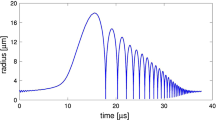Abstract
The phenomenon of sonoluminescence is observed when one or more air bubbles suspended in water collapse, emitting light in the presence of acoustic waves produced by ultrasonic transducers made of piezoelectric ceramic (PZT). For the phenomenon to occur is necessary that the bubbles can be trapped in the middle of the resonator container by means of an excitation at its resonance frequency. The objective of this study is to apply control systems technique to both the detection and the maintenance of the resonance frequency as the excitation mode of the resonator. The resonant mode is determined by comparing the signal applied to the resonator as delivered by the PZTs to the signal measured by the hydrophone. The initial part of this work presents a qualitative analysis of the acoustic system. The idea is to gain knowledge about the system frequency response function and use it as a basis for a control technique. The desired automation for this process is then achieved by developing control-based algorithms, with guaranteed stability and convergence properties. Numerical simulations and experimental results are also presented.











Similar content being viewed by others
References
Barber, B. P. (1992). Synchronous picosecond sonoluminescence. Ph.D. thesis, University of California, CA.
Barber, B. P., Hiller, R. A., Lfstedt, R., Putterman, S. J., & Weninger, K. R. (1997). Defining the unknowns of sonoluminescence. Physics Reports, 281, 65.
Brenner, M. P., Hilgenfeldt, S., & Lohse, D. (2002). Single-bubble sonoluminescence. Reviews of Modern Physics, 74(2), 425–484.
Dellavale, D., Sonnaillon, M. O., & Bonetto, F. J. (2008). FPGA based multi-harmonic control system for single bubble sonoluminescence. In: 4th Southern Conference on Programmable Logic (pp. 269–272).
Dellavale, D., Urteaga, R., & Bonetto, J. F. (2010). Analytical study of the acoustic field in a spherical resonator for single bubble sonoluminescence. The Journal of the Acoustical Society of America, 127(1), 186.
Garcia, R.O. (2012). Algoritmo para determinação da frequência de ressonância no experimento da sonoluminescência. Master’s thesis, Centro Federal de Educao Tecnolgica Celso Suckow da Fonseca—CEFET-RJ, Rio de Janeiro.
Mathworks: Matlab. (2010). http://www.mathworks.com. Accessed 12 May 2011.
McNamara, W. B, I. I. I., Didenko, Y. T., & Suslick, S. K. (1999). Sonoluminescence temperatures during multi-bubble cavitation. Nature, 401, 772.
Putterman, S. J., & Weninger, K. R. (2000). How bubbles turn sound into light. Annual Review of Fluid Mechanics, 32, 445.
Schanz, D., Metten, B., Kurz, T., & Lauterborn, W. (2012). Molecular dynamics simulations of cavitation bubble collapse and sonoluminescence. New Journal of Physics, 14, 113019.
Sewan, F., Beiling, C. D., & Fung, S. (2000). Stability control of single bubble sonoluminescence light. Physica B, 279, 233–236.
Slotine, J. J. E., & Li, W. (1991). Applied nonlinear control. Englewood Cliffs, NJ: Prentice-Hall.
Vignoli, L. L., de Barros, A. L. F., Thome, R. C., Nogueira, A. L. M., Paschoal, R. C., & Rodrigues, H. G. D. (2013). Modeling the dynamics of single-bubble sonoluminescence. European Journal of Physics, 34, 679.
Yu, A., & Wen-Juan, Z. (2012). The characteristics of sonoluminescence. Chinese Physics B, 21(1), 017806.
Acknowledgments
The authors thank the Brazilian foundations CNPq, FAPERJ, and CAPES for the financial support.
Author information
Authors and Affiliations
Corresponding author
Rights and permissions
About this article
Cite this article
Garcia, R.d.O., de Barros, A.L.F., Zachi, A.R.L. et al. Automation Process to Determine the Resonance Frequency in the Sonoluminescence Setup. J Control Autom Electr Syst 25, 461–469 (2014). https://doi.org/10.1007/s40313-014-0116-8
Received:
Revised:
Accepted:
Published:
Issue Date:
DOI: https://doi.org/10.1007/s40313-014-0116-8




